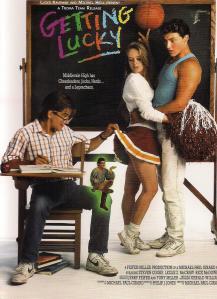
Stan (Jay Jay Warren) is a troubled teenager whose parents are dead and who consequently has to stay with his hard-drinking and emotionally abusive grandfather (Timothy Bottoms). Seeing his best friend Dommer (Cody Kostro) get bullied every day at school doesn’t make it any easier for Stan to stay out of trouble, and the fact that that the biggest and most handsome jerk of them all, Marble (Chris Petrovski), deflowered the girl Stan loves certainly doesn’t improve his mood. Meanwhile, the sheriff’s department also has an eye on him – and on top of all that, there’s a vampire hiding in the shed behind his house! When bodies start to pile up, Stan just wants all the chaos to stop, but vengeful Dommer gets some dangerous ideas about how a vampire might come in handy in evening up the score with his tormenters at school. Marred by some painfully generic dialogue, The Shed is nonetheless a successfully tense and sometimes humorous echo of the teen horror heyday of the 1980s. I give the drama a passing C but the scares definitely earn an A.
4 out of 5 stars. Ideological Content Analysis indicates that The Shed is:
[WARNING: SPOILERS!]
Drug-ambivalent. The grandfather stands as a cautionary depiction of an alcoholic, but Stan and Dommer get together and drink with no repercussions for either character apart from the grandfather griping about his grandson stealing his beer.
Anti-gun, guns appearing ineffective as a means of defense and mainly posing an offensive threat.
Anti-military, offering a degrading depiction of a Vietnam veteran in the grandfather, who brags about his service overseas while complaining that young people have no sense of duty.
Family-ambivalent. The characterization of the cruel grandfather is simplistically over-the-top, and parental figures and figures of authority generally are given negative depictions. Stan’s father selfishly committed suicide, and love interest Roxy (Sofia Happonen) mentions that her stepfather abused her mother. In each case, the character suffers from the absence of the real father. “We all hate our parents,” she claims. In one of The Shed’s lamest moments, young rebel Stan imagines the indignity of living in a “shitty suburban town, hating your neighbor, hating your wife, hating your parents for the way you turned out.” Militating against the anti-family content of the story, however, is the “In Loving Memory of Dad” dedication in the end credits.
Anti-Antifa. When, toward the end of the film, Dommer has decided to turn to murder, he appears in a T-shirt bearing an anarchist circle-A, anarchism being the ideology of choice of unhinged adolescent losers brimming with resentment and out for revenge.
Racist! The mixed-race Pitt (Francisco Burgos) is a second-tier bully and also a weak link when, after having joined forces with the protagonists, he shows himself a coward and falls prey to the vampire, becoming one himself.
Anti-Semitic! Probably not, actually; but with any vampire film there is always the question of the extent to which the filmmakers are conscious of and engage with the Judaic dimension of the European bloodsucker tradition. The case to be made for The Shed is flimsy, but it may be worth mentioning in this connection that Stan, hardly an archetypal Aryan hero, does have posters in his bedroom that feature runic writing. That the vampire is able to subvert mystery-meat Pitt and deploy him against Stan and Roxy could be read as reflecting Jewish manipulation of minority populations in majority-white societies, as well. As with many classic horror movies, the action in The Shed concludes with a purifying fire – which is, of course, to say a holocaust. The vampire might just as easily and perhaps more justifiably be interpreted as an expression of contagious and potentially homicidal or self-destructive teen angst, however. This reading would complement the movie’s doubly meaningful tagline: “Beware the evil within.”
Rainer Chlodwig von K.
Rainer is the author of Drugs, Jungles, and Jingoism.











